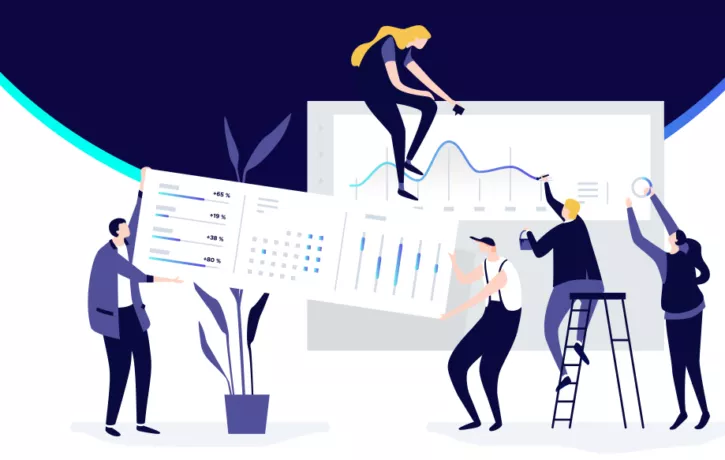Few things are more intimidating than starting a new job. New hires worry about everything from workplace politics to their professional competency before they’ve even set foot through the door.
Outdated staff training often puts the final nail in the coffin.
In addition to stressing out your staff, poor training prevents you from achieving key business metrics. After all, your employees can’t drive your performance goals forward unless they have a clear picture of their responsibilities, how to fulfill them, and how to work efficiently on workplace software.
Creating an effective approach to training is often a matter of coordinating the right resources and support. As soon as all the pieces come together, you’ll reach that aha! moment where suddenly, everything about your training model clicks.
The business need for optimal staff training
Lack of training and poorly planned onboarding results in low employee engagement and high turnover.
SHRM found that nearly one-third of employees leave their position within the first year of joining a new company. Insufficient training in digital organizations is one of the main culprits of voluntary turnover.
As the modern workplace becomes increasingly digital, software training is particularly important.
Employees are expected to perform with high levels of productivity and accuracy on a variety of complex and disparate software platforms. Failing to provide adequate training not only hurts their performance, it also raises frustration, stress, and disengagement.
Avoiding these consequences is simple. All it takes to build a more employee-centric model of instruction is incorporating contextual learning, experiential training, and user analytics.
Dive Deeper: The Employee Training Manifesto for Enhanced Productivity
Contextual learning: Empower employees to learn in the flow of work
Many organizations rely on more experienced staff members to train new employees. This approach should work in theory, but in practice, it results in inconsistent training as onboarding practices get sidelined in favor of “more important” tasks.
Forward-thinking organizations have started to recognize that the 1-on-1 training model isn’t a tenable method for software learning.
Instead, these companies favor in-app digital learning tools to guide employees through tasks on software platforms. For example, tools that enable contextual learning analyze dozens of parameters based on the user’s personal activity, goals, position, and other factors, to provide on-screen assistance that is tailored to their needs.
Even if an employee has no prior experience on a given platform, they will have the ability to efficiently complete tasks and access personalized support whenever they need it.
Another main benefit of these tools is employees’ ability to gain proficiency independently. When they don’t need to rely on another staff member or ask dozens of questions, employees feel more confident and autonomous.
Experiential training: Give your employees hands-on experience
Organizations that have adapted to the digital age have also started to incorporate experiential learning. Experiential  learning means giving employees the opportunity to learn by actually doing tasks, rather than passive learning, which involves watching demonstrations.
learning means giving employees the opportunity to learn by actually doing tasks, rather than passive learning, which involves watching demonstrations.
The most effective way to amass new digital skills is “jumping in and doing.” The best combination of learning techniques includes 70% experiential learning, 20% mentoring, and a 10% training philosophy.
Like what you’re reading? Subscribe to the blog for top insights delivered right to your inbox!
User analytics: Take a bird’s eye view
The good thing about taking a digital approach to staff training on enterprise software is the ability to analyze how well (or poorly) employees are using software.
A comprehensive digital learning tool, such as WalkMe’s Digital Adoption Platform (DAP), not only enables contextual learning and experiential approaches, it also offers a full range of user insights.
Administrators have the opportunity to assess key components of usability, such as where employees experience friction, how long they spend completing certain tasks, which features are going unutilized, and where they “drop off” or quit a process altogether.
Based on this information, training managers can create new levels of guidance or WalkThrus to ensure employees always have support to complete tasks.
Software-led staff training: Unlocking the potential of digital
With disruptive technologies emerging in workplaces at the drop of a hat, implementing agile and effective staff training methods is fundamental to long-term employee success.
Using a digital adoption platform allows a user to learn without relying on other employees or sitting through lengthy classroom sessions. In a digital economy where acquiring technical skills is paramount, organizations need to make their training practices more efficient.
While some organizations have yet to get the memo, there is a growing number that understands that software learning tools and experiential learning are essential for delivering training that keeps up to the speed of emerging technology.
WalkMe’s Digital Adoption Platform (DAP) transforms the user experience in today’s overwhelming digital world. Using artificial intelligence, engagement, guidance, and automation, WalkMe’s transparent overlay assists users to complete tasks easily within any enterprise software, mobile application or website. Discover how a DAP can revolutionize your business.

